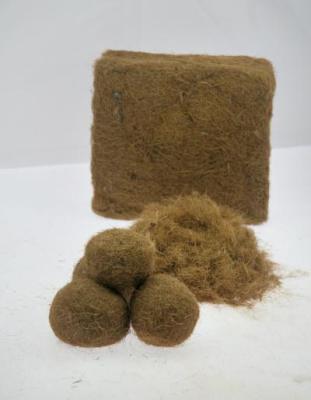Mar 8 2013
Throughout fall, winter and spring, Mediterranean beaches are littered with little balls of seaweed leaves from the Posidonia oceanica plant, more commonly known as Neptune grass.
 Seaweed balls can be used as insulation free of chemical additives. Credit: Fraunhofer ICT
Seaweed balls can be used as insulation free of chemical additives. Credit: Fraunhofer ICT
Although the natural material of these Neptune balls is regarded as a waste product and generally ends up as landfill, this readily abundant and renewable material is far too valuable to be thrown away.
It displays a variety of characteristics that make it of interest to the building trade: seaweeds are virtually non-flammable, resistant to mold, and can be used as insulating material without the need for chemical additives. It can be used as insulation between the rafters of pitched roofs, to insulate interior walls, or to reduce the amount of heat lost through building envelopes.
Fibers act as a buffer, absorbing water vapor and releasing it again without impairing its own ability to keep the building insulated. And with a salt content of just 0.5 to 2 percent, Neptune balls can be used to produce insulation material that will not rot away.
But how exactly is seaweed processed into a building material? A difficult task indeed as it is not easy to remove adherent sand from the Neptune balls. Added to which, individual fibers tend to catch easily on anything including one another and are quick to form new clumps, both during processing and later when being blown into spaces in need of insulation.
Suitable methods of turning Neptune balls into insulating material have been developed by the Fraunhofer Institute for Chemical Technology ICT in Pfinztal, in collaboration with industry partners NeptuTherm e.K., X-Floc Dämmtechnik-Maschinen GmbH, Fiber Engineering GmbH and RMC GmbH. The project partners' aim was to produce an insulating material capable of being stuffed or blown into the required space.
"Shaking the Neptune balls proved the best way of making sure we end up with fibers that are as long as possible and free of sand," says Dr. Gudrun Gräbe from Fraunhofer ICT. By carefully breaking up the clumps, Gräbe and her team were able to find the best way of acquiring fibers. Once all sand has been dislodged from the balls, a conveyor belt delivers them to the cutting mills, from where 1.5 to 2 centimeter fibers emerge undamaged and drop into plastic bags.
Staying cool with Posidonia fibers
The loose insulating material produced is capable of holding a considerable amount of energy: its value of 2.502 joules per kilogram kelvin (J/kgK) is 20 percent higher than that of wood or wood products, as a study conducted by the Fraunhofer Institute for Building Physics IBP in Holzkirchen shows. This means that the fibrous material keeps buildings cool in hot weather, shielding them from the heat of the day. And there is no doubt about how well Posidonia fibers insulate heat. "The material is employed in construction at sufficient density to prevent it from collapsing in on itself. The density required was determined by the Materials Testing Office MPA NRW in Dortmund," says Gräbe.
According to figures released by the eco-INSTITUTE in Cologne, seaweed is 100 percent organic and is entirely free of extraneous or toxic matter, making it also particularly suitable for allergy sufferers. Yet another advantage of Neptune balls is their favorable eco-balance, which Gräbe and her ICT colleagues have established. The entire manufacturing process requires very little energy. Neptune balls are harvested by hand and brought to Germany by sea from Tunisia and by road from Albania.
Stuffing or blowing
Installing the insulation itself poses little difficulty, and although installation is generally carried out by professionals, you can take on the job yourself. The fibrous material can be filled into the hollow spaces of roof constructions, walls and ceilings, and then packed tight by hand. It is advisable to use a machine to blow insulation into hard-to-reach spaces. The project is also responsible for producing a special blower capable of ensuring insulation reaches every last nook and cranny.
The company NeptuTherm e.K. has given its name to this insulating material from the sea and is already marketing and distributing it. Moreover, Posidonia fibers have already proved their worth in a range of new construction projects and renovations of existing buildings. There are now plans to develop solid, ecologically-sound sheets made from this material in order to offer a comprehensive system for insulating roofs, exterior façades, interior walls and basement ceilings. Researchers from Fraunhofer ICT have performed tests that show that producing such sheets is indeed feasible.